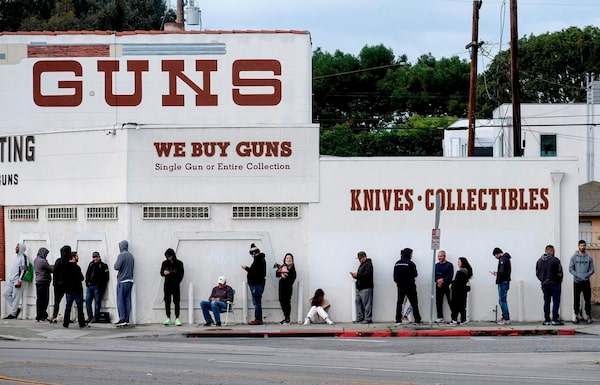
When it comes to guns – a lineup seen here outside a gun store in Culver City, California on March 15, 2020 – the rest of the world has long viewed the United States as being a little crazy.The Associated Press
Ian Buruma is an author, most recently, of A Tokyo Romance: A Memoir
Spooked by COVID-19, Americans not only stripped supermarket shelves of toilet paper and pasta, but also drove gun sales higher than ever.
Lobbyists for the U.S. gun industry want gun stores to be counted as “essential” businesses, like food shops and pharmacies. A number of states have readily complied, as has the Department of Homeland Security.
When it comes to guns, the rest of the world has long viewed the United States as being a little crazy. But there is something particularly odd about this latest rush to buy arms. Conservatives and gun lovers invoke history, tradition and the late-18th-century text of the U.S. Constitution to defend their right to carry anything from a Glock G-19 pistol to the popular AR-15 assault rifle.
The drafters of the U.S. Constitution’s Second Amendment insisted in 1791 that: “A well-regulated militia, being necessary to the security of a free State, the right of the people to keep and bear Arms, shall not be infringed.” The origin of this right goes back to the aftermath of the Glorious Revolution in England, when Protestant militias were authorized to bear arms to protect Parliamentary rule from a tyrannical monarchy.
In the U.S., too, militias of armed citizens were considered a necessary bulwark against a despotic federal state. The potential enemy was what U.S. President Donald Trump and his supporters like to call “the deep state,” an overweening federal government that should never be allowed to trample on the rights of freedom-loving people.
This is quite different from the motives of people buying assault rifles to defend “his or herself” in the age of COVID-19. What is most feared now is not the government, but lawlessness from a collapsing economy in a health crisis.
Coronavirus guide: Updates and essential resources about the COVID-19 pandemic
‘Can I take my kids to the park?’ And more coronavirus questions answered by André Picard
Such anarchy would resemble the “war of all against all” that Thomas Hobbes, traumatized by the English Civil War, warned against in the 17th century. To preserve the peace and a civilized society, Hobbes argued in Leviathan, citizens must hand over sovereignty, and thus the right to use force, to an almighty state. Democracies today are not almighty, but they do claim a monopoly on the legitimate use of force – as do dictatorships, of course.
The U.S. federal government was never trusted with a monopoly on the use of armed force. But for the most part, efforts were made – not always successfully – to limit violence by restricting the types of guns people could own and the types of people who could own them. Until the 1970s, the National Rifle Association was an organization of gun enthusiasts that focused on firearms safety.
But then the NRA, provoked by one of those periodic panics that drive so many Americans to seek guns, switched its position to become a radical proponent of private gun ownership. And when large numbers of Americans panic, race is usually in the background.
Frightful violence was unleashed by gun-toting Ku Klux Klan members beginning in the 1860s, when white southerners sought to restore the racial hierarchy upended by the end of slavery and Reconstruction in the former Confederate states. This resulted in paranoid rhetoric about black men threatening white property and women; shootings and lynching followed.
Echoes of this resounded in the 1970s, when white resistance to court-ordered school integration peaked. Indeed, what really pushed the NRA into active politics and lobbying an individual right to carry guns was the expansion of civil rights for African-Americans under president Lyndon Johnson. This triggered the flight of southern Democrats to the Republican Party, the active involvement of evangelical Christians in right-wing politics and the demand for a new interpretation of the Second Amendment. Images of Black Panther revolutionaries taking up arms to defend themselves against racism seemed to confirm many whites’ worst fears.
Years of lobbying and cajoling by the NRA, and the steady radicalization of the Republican Party, finally paid off in 2008 when five right-wing Supreme Court justices ruled (against the other four) that the Second Amendment guarantees the right of individuals to carry guns to protect “hearth and home.”
The “war” against COVID-19, belatedly declared by Mr. Trump, is not on the surface the same thing as racial resentment of minorities. But fear of lawlessness is fear of poor and desperate mobs, deprived of jobs and health care. It is fear of a war of all against all – or perhaps not quite all.
Christopher Mio and Meghan Hoople found themselves jobless and wanting to help in the wake of COVID-19 isolation in Toronto. After flyering their neighbourhood with a free-of-charge offer, they received an outpouring of support and requests from people in need.
The Globe and Mail
Keep your Opinions sharp and informed. Get the Opinion newsletter. Sign up today.
Sign up for the Coronavirus Update newsletter to read the day’s essential coronavirus news, features and explainers written by Globe reporters.